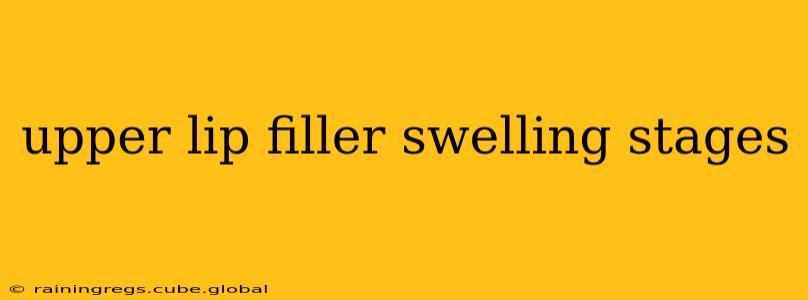Getting lip filler is a popular cosmetic procedure, offering a boost of volume and definition. However, swelling is a common side effect, and understanding the different stages can help manage expectations and ensure a smooth recovery. This comprehensive guide details the typical swelling stages after upper lip filler, offering insights into what to expect and how to minimize discomfort.
What are the stages of swelling after upper lip filler?
Swelling after upper lip filler typically follows a predictable pattern, though individual experiences may vary. The intensity and duration depend on several factors including the amount of filler injected, the type of filler used, and individual healing responses. Generally, you can expect these stages:
Stage 1: Immediate Swelling (0-24 hours)
Immediately following the procedure, you'll likely experience some swelling, redness, and possibly bruising. This is a normal reaction to the injection and the body's natural response to the introduction of a foreign substance. The swelling might be quite noticeable at this stage.
Stage 2: Peak Swelling (24-72 hours)
Over the next 24-72 hours, the swelling will usually reach its peak. This isn't necessarily a cause for alarm; it's simply your body's inflammatory response working to integrate the filler. The swelling might feel tight or uncomfortable during this phase.
Stage 3: Gradual Reduction (3-7 days)
After 72 hours, you'll typically notice a gradual reduction in swelling. The rate of reduction varies, but most individuals see a significant improvement within this timeframe. The lip may still appear slightly fuller than the final result during this stage.
Stage 4: Final Result (7-14 days)
By 7-14 days post-procedure, most of the swelling should have subsided, revealing the final result. It's important to remember that the final result might not be fully apparent immediately; it can take several weeks for the filler to settle completely and the natural swelling to fully resolve.
How long does upper lip filler swelling last?
The duration of swelling after upper lip filler varies from person to person, but generally, the majority of swelling resolves within 7 to 14 days. However, some residual swelling or subtle changes might persist for several more weeks as the filler settles completely.
What can I do to reduce swelling after upper lip filler?
Several strategies can help minimize swelling and discomfort:
- Ice packs: Applying ice packs to the area for 15-20 minutes at a time, several times a day, can help reduce inflammation.
- Elevation: Keeping your head elevated while sleeping can also help minimize swelling.
- Avoid strenuous activity: Refrain from strenuous exercise or activities that might increase blood flow to the face for the first few days.
- Avoid alcohol and aspirin: These can thin the blood and increase bruising and swelling.
- Follow your injector's instructions: Carefully follow all post-procedure instructions provided by your medical professional.
Is it normal for upper lip filler to swell up a lot?
While some swelling is expected, excessive or prolonged swelling could indicate a problem. It's crucial to contact your injector if you experience excessive swelling, severe bruising, or any other concerning symptoms. They can assess the situation and provide appropriate guidance.
How can I tell if my lip filler swelling is excessive?
Excessive swelling might manifest as significantly more swelling than expected based on the information provided above, or if the swelling is accompanied by other symptoms like severe pain, discoloration, or difficulty breathing. Contact your injector immediately if you're concerned about the level of swelling.
What should I do if my upper lip filler is still swollen after two weeks?
If significant swelling persists after two weeks, it's crucial to consult your injector. They can assess the situation, rule out any complications, and determine the best course of action. This might involve additional treatment or management strategies.
This information is for educational purposes only and does not constitute medical advice. Always consult a qualified medical professional before undergoing any cosmetic procedure. Remember that individual results may vary, and it’s essential to discuss your expectations and concerns with your injector beforehand.
